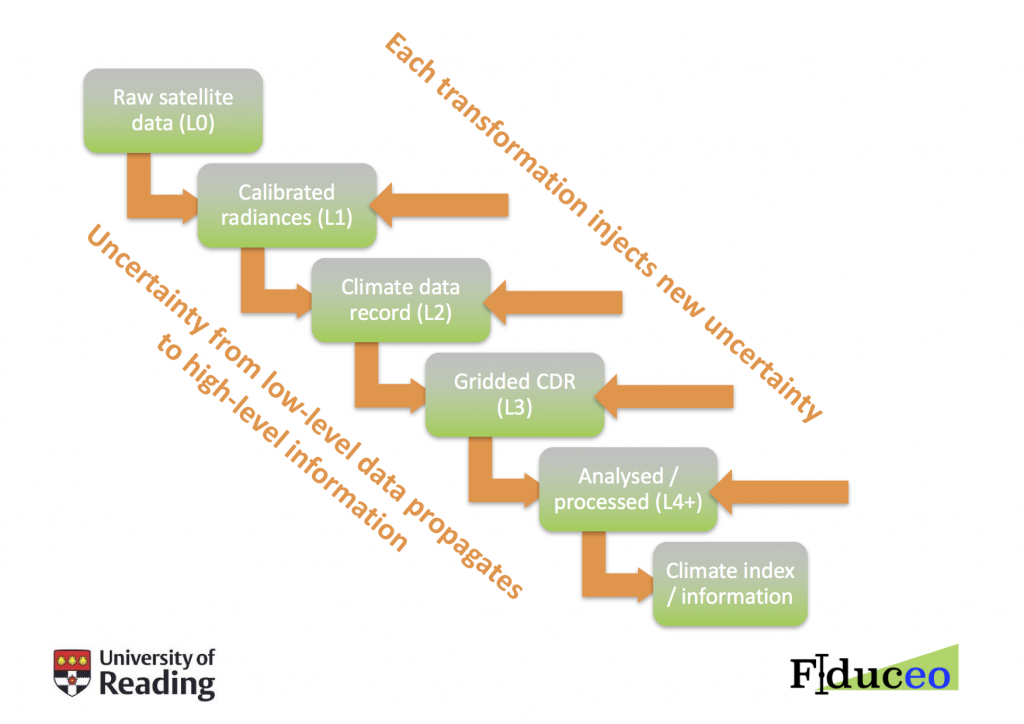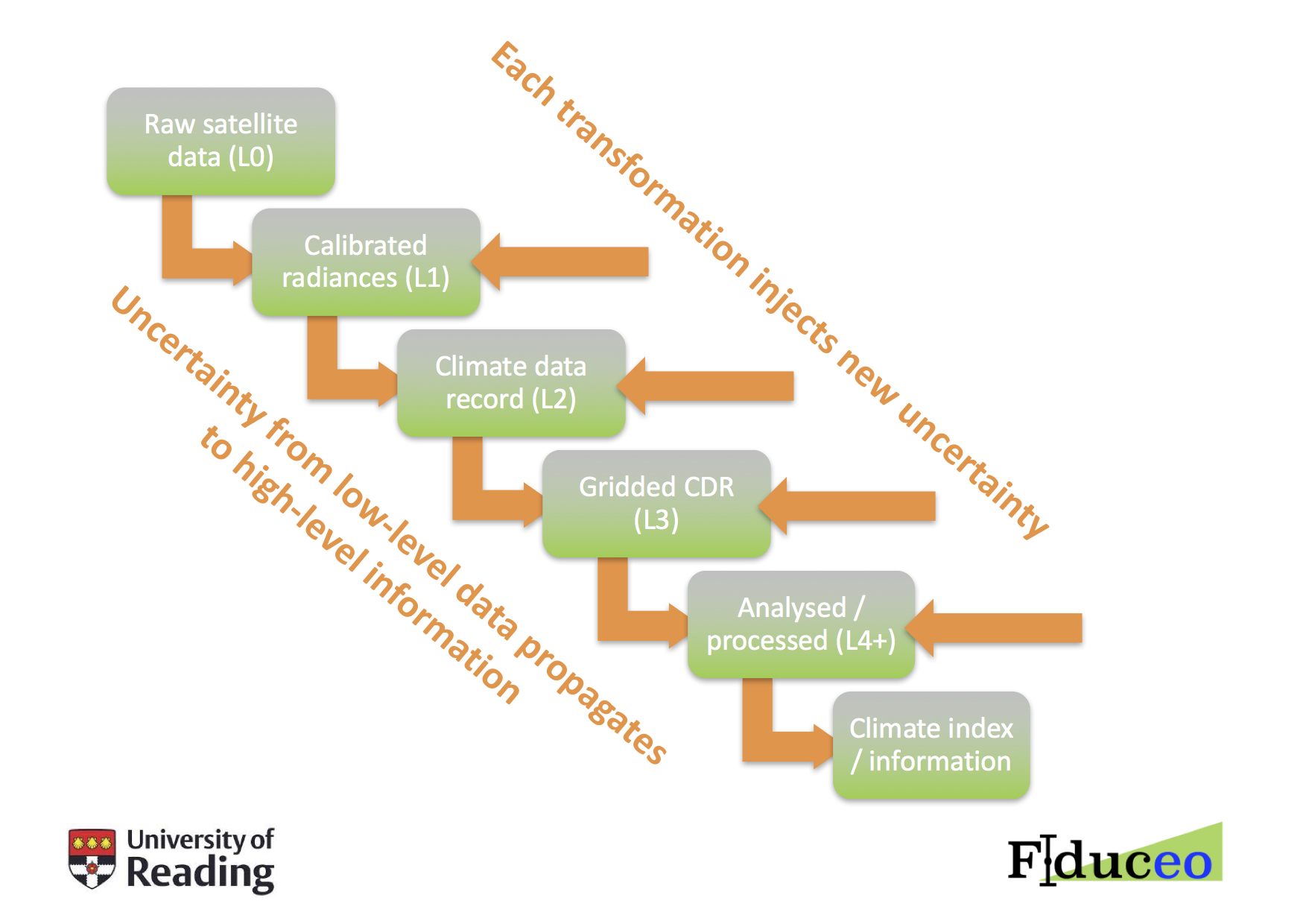The FIDUCEO project aims to unlock the full potential of selected historic satellite missions to provide climate-quality multi-decadal time series of observations, useful to climate science and society.
The main strands of this effort are:
- to increase the ability of such datasets to answer questions about long-term climatic variations, by harmonisation (essentially, stabilising the observations over time)
- to add uncertainty information to the radiance observations (“fundamental climate data records”, FCDRs), treating carefully effects that cause errors on all space-time scales
- to demonstrate how FCDR uncertainty information can be propagated to climate data records (CDRs)
Although in FIDUCEO we are working on historic missions, we are increasingly aware that the methods and tools being pioneered in pursuit of the second strand should inform the development phases of future missions, such as sensors on future Copernicus, meteorological and ESA missions.
This would involve a change of practice during mission development (“phases B to D”) from a “compliance focus” to a “metrology focus” when considering on instrument performance and errors. To simplify the present situation: the error characteristics of satellite sensors in development are investigated primarily to prove prior to launch the compliance of a sensor with a number of requirements. But, the understanding of the observational uncertainties gained by these investigations is not communicated to users: it is not embedded as quantitative uncertainty information in radiance products distributed by space agencies; it is not systematically and accessibly published to inform radiance users; it is not used to generate estimates of the uncertainty arising in derived geophysical products from the radiance uncertainties.
This seems liked a wasted opportunity. (There are, of course, exceptions to and variations on the above situation, but I think it is a valid caricature.)
Moving from a “compliance focus” to a “metrology focus” would involve:
- using error characterisation activities not only to ensure compliance with sensor specifications, but also to construct a proper model of sensor uncertainty in flight
- giving more attention to error correlation structures, so that the model for uncertainty includes understanding of how uncertainty scales across all the space-time scales relevant to the applications of the data
- encapsulating the understanding of uncertainty in freely accessible publications, thereby giving traceability to the uncertainty information
- inclusion of per-datum uncertainty information in radiance products (level-1/FCDRs) as routine practice by space agencies
The table at the foot of this blog gives a couple of illustrations of the change of focus in a little more detail.
There are obstacles: the above programme would entail higher costs because of some increased effort, and where proprietary information is involved a solution for maximising the public traceability of the uncertainty information would need to be negotiated. These problems are soluble, if there is sufficient perceived benefit.
So, what would be the benefits? If space agencies were routinely to provide well-characterised uncertainty information in level-1 products from future missions:
- users of the data would know which observations are more and less certain
- centres that assimilate radiances, such as meteorological agencies, could exploit those uncertainties in assimilation
- users deriving geophysical products, such as CDRs, can straightforwardly and traceably quantify a significant portion of their product uncertainty
- ultimately, the uncertainty in the higher-level forms of information used by environmental modellers and decision makers can be quantified and communicated (see figure)

This would be a valuable step towards achieving in Earth Observation the basic scientific good practice of having a well-founded uncertainty estimate available for every observation provided to users, at all levels of data set.
| Aspect | Compliance focus | Metrology focus |
|---|---|---|
| Estimating the magnitude of pixel-level uncertainty (e.g., in radiance) | Worst-case combination of uncertainty from error sources to compared against a (generally) aggregated total uncertainty requirement. Deliberately pessimistic to ensure compliance and acceptance. | Individual models/calculations of uncertainty from error sources, traceably documented per error source. Realistic combination to inform expected in-flight characteristics. |
| Characterising the error-correlation structure across pixels and channels | Only in response to specific relevant requirements (e.g. cross-talk limits). Not considered for many error sources. | Integral part of uncertainty characterisation for all error sources |
| Traceably documenting uncertainty information | Documentation focused on acceptance milestones. Results perhaps mixed with commercially sensitive and confidential material, usually not available in a form supporting traceability | Documentation freely available and organised such as to support systematic traceability |
| Dissemination of understanding of error sources to users | Not actively or systematically attempted — generic information may be published. Not quantitatively integrated into satellite products | Understanding is embedded in product processing chain in order to include quantitative uncertainty information directly in satellite products at L1 |

